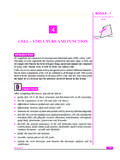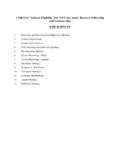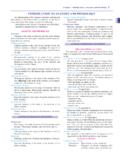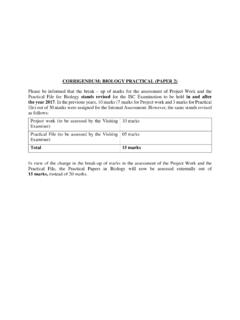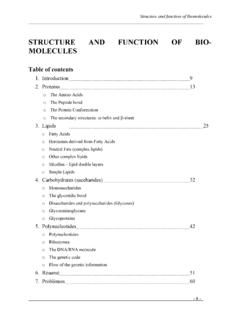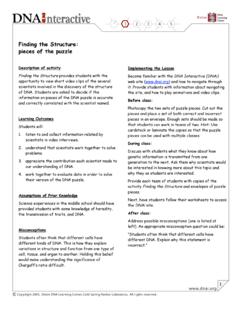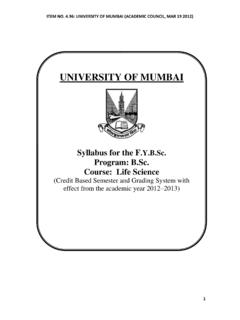Transcription of FIRST QUARTER TOPICS : 1. Introduction to …
1 Lynn English High School Science Department 9th Grade biology Curriculum Map FIRST QUARTER TOPICS : 1. Introduction to biology 2. Chemistry 3. Cell Structure & Function 4. Biochemistry 5. Digestive System Topic Introduction TO biology MA Standards Scientific Inquiry Skills 1-4 Mathematical Skills Concepts THEMES OF biology CHARACTERISTICS OF LIFE SCIENTIFIC METHOD LAB SAFETY SI MEASUREMENT USE OF MICROSCOPE Essential Questions What do biologists study? What are the necessary characteristics of life? What are the themes of biology ? Performance Objectives Students will be able to: List six unifying themes of biology . Explain how organisms get the energy they need to survive. Describe the main difference between the structure of a living thing and that of a nonliving thing. List six characteristics of life Describe the hierarchy in nature from atoms b io m e Define and give examples of observing, measuring, organizing, and analyzing data, inferring, and modeling.
2 Explain the relationship between hypothesizing, predicting, and experimenting. Compare light microscopes with electron microscopes in terms of magnification and resolution. Explain the advantages of the Syst me International d Unit s. *Modified from Modern biology (2002) Resources Textbook: Modern biology (2002) Scientific Method Graphic Organizer Reading: Chapter 1: The Science of Life Lecture Notes Study of Life Notes-Massengale Identifying Controls and Variables Chapter 1 Powerpoint The Levels of Organization. Labs/Activities A2: Comparing living and nonliving things Characteristics of Life Concept Map-GROUCH Lab C1: Microscope Safety Contract and Quiz SI Measurement Lab Characteristics of Life Concept Map Identifying Controls and Variables The Language of Science Parts of the Microscope Microscope Lab Metric Measurement Lab Making Inferences The Martian and the Car Homework Sections Review Questions Vocabulary Chapter Review Questions Directed Reading Questions Study Guide Worksheets 1-1 Worksheet 1-2 Worksheet 1-3 Worksheet 1-4 Worksheet Assessment Chapter 1 Test Exam Pro Test Questions Lab Safety Pretest Lab Practical on Lab Safety and Equipment Lynn English High School Science Department 9th Grade biology Curriculum Map Topic CHEMISTRY MA Standards The Chemistry of Life.
3 BASIC CHEMISTRY Recognize that biological organisms are composed primarily of very few elements. The six most common are C, H, N, O, P, S. SIS1-2 Concept Chemical elements form organic molecules that interact to perform the basic functions of life Essential Questions How do elements combine to form organic molecules? Why are organic molecules the chemistry of life? How is all life affected by chemical reactions? Performance Objectives Students will be able to: Define element, atom, compound, and molecule. Explain models of the atomic structure of the six most common elements-C, H, O, N, P, and S, found in living organisms. Explain what determines an atom s stability. Contrast ionic and covalent bonds. Define reaction and be able to identify reactants and products in a chemical equation. Describe how energy changes are involved in chemical reactions. (activation energy) Explain how enzymes affect chemical reactions in organisms.
4 Define solution, solute, solvent, and concentration. Understand the role of pH and buffers in living things. Resources Textbook: Modern biology (2002) Reading: Chapter 2-Chemistry Lecture Notes Chapter 2 Notes. Chemistry PPT Periodic Table of Elements. Labs/Activities Making Models Lab: Solutions Lab: ph Adopt an Element Giant Periodic Table Homework Sections Review 2-1-3 Study Guide Worksheets 2- 1 Worksheet 2- 2 Worksheet 2- 3 Worksheet Chapter Review Questions Assessment Warm-ups: help to check for prior knowledge or understanding of previous day s lesson Chapter 2 Test Exam Pro Test Questions Lab reports Lab rubric Homework Rubric School Wide Rubric Lynn English High School Science Department 9th Grade biology Curriculum Map Topic BIOCHEMISTRY MA Standards ORGANIC MOLECULES Describe the basic molecular structures and primary functions of the four major categories of organic molecules.
5 Carbohydrates lipids proteins nucleic acids Concepts Chemical elements form organic molecules that interact to perform the basic functions of life Essential Questions Why is carbon an important element to all living organisms How are organic molecules and their structure the basis of living organisms Performance Objectives Students will be able to: Describe the polar nature of water and how this property of water affects its ability to dissolve substances. Define organic compounds and name six elements often found in organic compounds. Explain why carbon forms so many different compounds. Give examples of and describe the basic molecular structure and function of: carbohydrates lipids proteins nucleic acids Explain how different processes need a constant supply Resources Textbook: Modern biology (2002) Reading: Chapter 3-Biochemistry Lecture Notes PPT: Properties of Water Carbon Compounds PPT Carbohydrates PPT Proteins PPT Lipids PPT Nucleic Acids PPT Labs/Activities Organic Molecules Concept Map Food Chemistry Constructing Organic Molecules Collins Brainstorm Homework Keywords Section Reviews: 1-3 Chapter Review Questions 3- 1 Worksheet 3- 2 Worksheet 3-3 Worksheet Assessment Collins.
6 Organic Molecules Chapter 4 Test Exam Pro Test Questions with Essays & Problems Lab reports Lab rubric Homework Rubric School Wide Rubric Lynn English High School Science Department 9th Grade biology Curriculum Map Topic ANATOMY & PHYSIOLOGY: DIGESTIVE SYSTEM MA Standards Anatomy and physiology Digestive System Explain generally how the digestive system (mouth, pharynx, esophagus, stomach, small and large intestines, rectum) converts macromolecules from food into smaller molecules that can be used by cells for energy and for repair and growth. Concepts Central Concepts: There is a relationship between the organization of cells into tissues and the organization of tissues into organs. The structures and functions of organs determine their relationships within body systems of an organism. Homeostasis allows the body to perform its normal functions. Essential Questions How does the digestive system break down food into organic molecules and provide energy for living organisms Performance Objectives Students will be able to.
7 List the major organs of the digestive system Relate the structure of each organ with its function in mechanical digestion Identify the source of each major digestive enzyme, and describe the function of the enzyme Summarize the process of absorption in both the small and large intestine Resources Modern biology ( 2002) Reading chapter 49-1,2 Lecture Notes Digestive PPT Labs/Activities Digestive Travel Brochure McMush Lab Food Chemistry Digestive System Webquest Homework Section Reviews Keywords Chapter Review Assessment Lynn English High School Science Department 9th Grade biology Curriculum Map Topic CELL STRUCTURE & FUNCTION MA Standards : CELL ORGANELLES Relate cell parts/organelles (plasma membrane, nuclear envelope, nucleus, nucleolus, cytoplasm, mitochondrion, endoplasmic reticulum, Golgi apparatus, lysosome, ribosome, vacuole, cell wall, chloroplast, cytoskeleton, centriole, cilium, flagellum, pseudopod) to their functions.
8 Explain the role of cell membranes as a highly selective barrier (diffusion, osmosis, facilitated diffusion, and active transport). : PROKARYOTES/EUKARYOTES Compare and contrast, at the cellular level, prokaryotes and eukaryotes (general structures and degrees of complexity). Concept Cells have specific structures and functions that make them distinctive. Processes in a cell can be classified broadly as growth, maintenance, and reproduction Essential Questions Why are cells considered the basic unit of structure of life? How does life at the cellular level affect life at levels further up in the hierarchy of life? Performance Objectives Students will be able to: State the cell theory. Describe the relationship between cell shape and cell function. Distinguish between prokaryotes and eukaryotes. Describe the structure, composition, and function of the cell membrane.
9 Name the major organelles found in a eukaryotic cell, and describe their structure functions. Explain how chloroplasts and mitochondria are related. Describe additional three structures characteristic of plant cells. Distinguish between tissues, organs, and organ systems. Resources Textbook: Modern biology (2002) Reading: Chapter 4: Structure and Function of the Cell Lecture Notes Chapter 4: The Cell Notes Cells Alive WEBSITE Amazing Cell Video Cell Overview PPT Tour of The Cell PPT Labs/Activities Cell Web Quest GO Cell Analogy Project Cell Analogy Collage Cell Model Lab: Observing Specialized Cells Homework Sections Review 4-1-2 Chapter Review Questions Keywords Study Guide Worksheets 4-1 Worksheet 4-2 Worksheet Assessment Warm-ups: help to check for prior knowledge or understanding of previous day s lesson Collins: Comparing and Contrasting Prokaryotic and Eukaryotic Cells Collins: Comparing and Contrasting Plant and Animal Cells Collins.
10 Compare and Contrast 2 cell organelles Lab reports Lab rubric Homework Rubric School Wide Rubric Chapter 4 Test Exam Pro Test Questions Lynn English High School Science Department 9th Grade biology Curriculum Map Topic CELL TRANSPORT MA Standards : CELL TRANSPORT Explain the role of cell membranes as a highly selective barrier (diffusion, osmosis, facilitated diffusion, and active transport). Concepts Cells have specific structures and functions that make them distinctive. Processes in a cell can be classified broadly as growth, maintenance, and reproduction Essential Questions How is the structure of the cell membrane related to its function? Explain two important functions of the cell membrane Performance Objectives Students will be able to: Explain how equilibrium is established as a result of diffusion Distinguish between diffusion and osmosis Explain how substances cross the cell membrane through facilitated diffusion.

